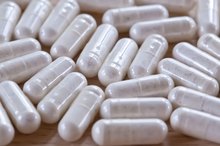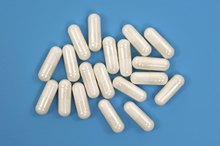What does fact checked mean?
At Healthfully, we strive to deliver objective content that is accurate and up-to-date. Our team periodically reviews articles in order to ensure content quality. The sources cited below consist of evidence from peer-reviewed journals, prominent medical organizations, academic associations, and government data.
- "Journal of Dairy Science"; Purification and Identification of Bovine Cheese Whey Fatty Acids Exhibiting in Vitro Antifungal Activity; M.Clément, et al.; July 2008
- "Journal of Dairy Science"; Purification and Identification of Bovine Cheese Whey Fatty Acids Exhibiting in Vitro Antifungal Activity; M.Clément, et al.; July 2008
- "Japanese Journal of Infectious Diseases"; Synergistic Antifungal Effect of Lactoferrin with Azole Antifungals Against Candida Albicans and a Proposal for a New Treatment Method for Invasive Candidiasis; T. Kobayashi, et al.; July 2011
- "Japanese Journal of Infectious Diseases"; Synergistic Antifungal Effect of Lactoferrin with Azole Antifungals Against Candida Albicans and a Proposal for a New Treatment Method for Invasive Candidiasis; T. Kobayashi, et al.; July 2011
- "International Journal of Antimicrobial Agents"; Fungicidal Activity of Human Lactoferrin-derived Peptides Based on the Antimicrobial αβ Region; N. Kondori, et al.; January 2011
- "International Journal of Antimicrobial Agents"; Fungicidal Activity of Human Lactoferrin-derived Peptides Based on the Antimicrobial αβ Region; N. Kondori, et al.; January 2011
- "FEMS Yeast Research"; Whey-Derived Free Fatty Acids Suppress the Germination of Candida Albicans in Vitro; M. Clément, et al.; March 2007
- "FEMS Yeast Research"; Whey-Derived Free Fatty Acids Suppress the Germination of Candida Albicans in Vitro; M. Clément, et al.; March 2007
- "Eukaryotic Cell"; Conjugated Linoleic Acid Inhibits Hyphal Growth in Candida Albicans by Modulating Ras1p Cellular Levels and Downregulating Tec1 Expression; J. Shareck, et al.; April 2011
- "Eukaryotic Cell"; Conjugated Linoleic Acid Inhibits Hyphal Growth in Candida Albicans by Modulating Ras1p Cellular Levels and Downregulating Tec1 Expression; J. Shareck, et al.; April 2011
The information contained on this site is for informational purposes only, and should not be used as a substitute for the advice of a professional health care provider. Please check with the appropriate physician regarding health questions and concerns. Although we strive to deliver accurate and up-to-date information, no guarantee to that effect is made.
Does Whey Protein Promote Yeast Infections?
Whey protein, made from the watery waste of cheese manufacture, contains valuable immunoglobulins, enzymes, proteins and lipids that provide antimicrobial effects against a variety of pathogens. Some components of whey protein inhibit yeast infections. Consult your doctor before using whey protein to treat a yeast infection or other medical condition.
GLA
Whey showed antibacterial, antiviral and antifungal activity in a study published in the July 2008 issue of the "Journal of Dairy Science." In the test tube study, free fatty acids in whey inhibited germination of Candida albicans, the fungus responsible for many yeast infections 14. Whey also inhibited growth of Aspergillus, a type of mold that causes respiratory infections. Active antifungal fatty acids in whey include capric acid, laruoleic acid myristoleic acid and gamma-linolenic acid, also known as GLA. Researchers noted that GLA demonstrated the most potent antifungal effects. Further studies to confirm these preliminary results in humans are needed.
- Whey showed antibacterial, antiviral and antifungal activity in a study published in the July 2008 issue of the "Journal of Dairy Science."
Lactoferrin
Probiotics & Herpes
Learn More
Lactoferrin, an immune-boosting protein abundant in whey protein, helps prevent yeast infections by scavenging iron before it has a chance to become oxidized, according to A.S. Naidu, author of "Lactoferrin: Natural, Multifunctional, Antimicrobial." Pathogenic bacteria and fungi feed on oxidized iron, so limiting its levels has a decidedly antifungal effect. A study published in the July 2011 issue of the "Japanese Journal of Infectious Disease" found that lactoferrin increased effectiveness of the antifungal drug fluconazole 2. Researchers conclude that lactoferrin shows potential for use in treating drug-resistant fungal strains.
- Lactoferrin, an immune-boosting protein abundant in whey protein, helps prevent yeast infections by scavenging iron before it has a chance to become oxidized, according to A.S. Naidu, author of "Lactoferrin: Natural, Multifunctional, Antimicrobial."
- A study published in the July 2011 issue of the "Japanese Journal of Infectious Disease" found that lactoferrin increased effectiveness of the antifungal drug fluconazole 2.
Variable Effectiveness
Swedish researchers found antifungal effects in short protein molecules, known as lactoferrin-like peptides, present in whey protein, in a study published in the January 2011 issue of the "International Journal of Antimicrobial Agents." The peptides inhibited some species of Candida, including Candida albicans, but not others, in the test-tube study 3. Researchers concluded that antifungal effects of the peptides show potential as antifungal agents in the treatment of most types of Candida. Further studies on the effects of lactoferrin in humans is warranted.
- Swedish researchers found antifungal effects in short protein molecules, known as lactoferrin-like peptides, present in whey protein, in a study published in the January 2011 issue of the "International Journal of Antimicrobial Agents."
Free Fatty Acids
List of Probiotic Bacteria
Learn More
A study published in the March 2007 issue of the journal "FEMS Yeast Research" found that free fatty acids in whey protein inhibit Candida from reproducing 4. The fatty acids lauric acid, myrisoleic acid, linoleic acid and arachidonic acid were the most active of those tested in the study. Canadian researchers confirmed the antifungal effects of linoleic acid against Candida albicans in a study published in the April 2011 issue of the journal "Eukaryotic Cell." Researchers concluded that linoleic acid represents an unexplored natural source for controlling Candida infection. Human clinical trials are needed to confirm these promising preliminary results.
- A study published in the March 2007 issue of the journal "FEMS Yeast Research" found that free fatty acids in whey protein inhibit Candida from reproducing 4.
Related Articles
References
- "Journal of Dairy Science"; Purification and Identification of Bovine Cheese Whey Fatty Acids Exhibiting in Vitro Antifungal Activity; M.Clément, et al.; July 2008
- "Japanese Journal of Infectious Diseases"; Synergistic Antifungal Effect of Lactoferrin with Azole Antifungals Against Candida Albicans and a Proposal for a New Treatment Method for Invasive Candidiasis; T. Kobayashi, et al.; July 2011
- "International Journal of Antimicrobial Agents"; Fungicidal Activity of Human Lactoferrin-derived Peptides Based on the Antimicrobial αβ Region; N. Kondori, et al.; January 2011
- "FEMS Yeast Research"; Whey-Derived Free Fatty Acids Suppress the Germination of Candida Albicans in Vitro; M. Clément, et al.; March 2007
- "Eukaryotic Cell"; Conjugated Linoleic Acid Inhibits Hyphal Growth in Candida Albicans by Modulating Ras1p Cellular Levels and Downregulating Tec1 Expression; J. Shareck, et al.; April 2011
Writer Bio
Tracey Roizman, DC is a writer and speaker on natural and preventive health care and a practicing chiropractor. She also holds a B.S. in nutritional biochemistry.









